Traditionalist Issues
 |
 |
 |
 |
 |
 |
 |
Dialogue Mass - XXX
Liturgical Inversion: People First, God Second
Turning again to the venerable formula lex orandi, lex credendi, we can see that the liturgy reveals what we truly believe and how we view ourselves in relation to God. It is evident that every part of the traditional Mass – each of its rituals, gestures and prayers – has a transcendent dimension reflecting the supreme honor due to God. But there is an inversion at the heart of the Liturgical Movement that reflects the exaltation of man and has led to the almost total neglect of reverence and a sense of the sacred in the liturgy.
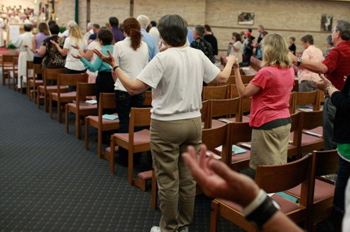 Jungmann was dissatisfied (but is not dissatisfaction the hallmark of all progressivists?) with a liturgy that was “viewed almost exclusively as an action of God.” He preferred, instead, to shift the center of gravity towards the “People of God at prayer.” He believed that the people, rather than the priest alone, should be given a central role in the liturgy even during the Canon, the most sacred and solemn part of the Mass.
Jungmann was dissatisfied (but is not dissatisfaction the hallmark of all progressivists?) with a liturgy that was “viewed almost exclusively as an action of God.” He preferred, instead, to shift the center of gravity towards the “People of God at prayer.” He believed that the people, rather than the priest alone, should be given a central role in the liturgy even during the Canon, the most sacred and solemn part of the Mass.
The following extract from his magnum opus illustrates this in a nutshell:
“A thanksgiving prayer rises from the congregation and is borne up to God by the priest; it shifts into the words of consecration, and then into the oblation of the sacred gifts and this oblation, in turn, concludes with a solemn word of praise.” (1)
Here the people’s thanksgiving prayer shades imperceptibly into the words of Consecration so that any distinction between the priest and the laity is extremely blurred. The impression is given that it is the assembled people who are the actual ministers of the Consecration and who together fulfill Christ’s Institution.
“It is the whole believing people who make up the Ecclesia, which approaches God in prayer through the liturgy.” (2) That, Jungmann insisted, was of the essence: “In the early Christian age the liturgy was essentially corporate public worship” (3)
In other words, he was teaching the Protestant notion that the Eucharist is essentially a banquet of the assembled people; it was their action of praise and thanksgiving that gave meaning to the rites. According this progressivist notion, the Church went astray in privileging the priest over the laity in the celebration of the liturgy.
Jungmann’s influence was far-reaching and profound, judging from the man-centered liturgies that are now the norm. There is little, if any, awareness of God in this typical understanding of the Novus Ordo explained by the Carmelite Fr. Gregory Klein:
“Eucharist begins with the assembly, the people gather in the name of Jesus Christ. While the details of the environment in which the people gather, the occasion on which people gather, and the manner in which people gather are not unimportant, Eucharist is about people.” (4)
Less reverence towards God, more ‘active participation’
Jungmann attacked the traditional Mass on the grounds that the congregation had no active role to play, and complained that, correspondingly, “the Mass becomes all the more the mystery of God’s coming to man, a mystery one must adoringly wonder at and contemplate from afar.” (5) [emphasis added]
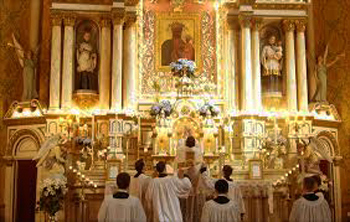 This is a clear indication that Jungmann saw an inverse correlation between the active participation of the laity and a God-centered liturgy: Insofar as the former decreases, the latter increases.
This is a clear indication that Jungmann saw an inverse correlation between the active participation of the laity and a God-centered liturgy: Insofar as the former decreases, the latter increases.
So, when God and man are weighed in the balance, a marked see-saw effect is produced. Too high an honor paid to God in the liturgy was, according to Jungmann to be avoided, on the grounds that it debased the dignity of the all-important lay people: their “rights” to “actively participate” should always be in the ascendant.
But, since when was it considered unjust and oppressive to put the supreme reverence due to God before the interests of the laity? Only since the Liturgical Movement decided that God was an inconvenient obstacle to their supposed rights to “actively participate” in the liturgy.
With Vatican II, the see-saw has definitely been tilted in favor of man: the Liturgy Constitution mandates that “active participation by all the people is the aim to be considered before all else.” And, lest anyone should fail to appreciate the supreme importance of such participation, the Liturgy Constitution rubs it well in: the phrase is repeated 17 times in the document. (6)
Reverence towards the Blessed Sacrament, an obstacle
As reverence – or lack of it – is ultimately a question of faith, Jungmann revealed the basic objection of the liturgical reformers to putting God first:
“We must see the Tabernacle as a hindrance to the celebration [of Mass] … because the presence of the Blessed Eucharist from the very start of the Mass must prejudice the logic of the course of the celebration.” (7)
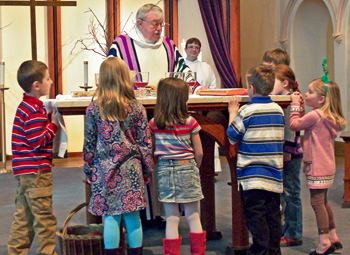 It was this specious and diabolical logic that turned the liturgy into the “work of the people” and the church building into the “house of the people” in which God’s dwelling place is daily dishonored by man-centered celebrations.
It was this specious and diabolical logic that turned the liturgy into the “work of the people” and the church building into the “house of the people” in which God’s dwelling place is daily dishonored by man-centered celebrations.
This “people first” logic led to the virtual disappearance of the reverence and solemnity that have traditionally characterized the liturgy, the reception of Communion and devotions in honor of the Blessed Sacrament. And their sudden withdrawal was bound to impact negatively on faith in the Real Presence.
For the symbols and signs of adoration communicated something of the sacred mysteries to the humble faithful in ways that the words by liturgical scholars often failed to convey
Jungmann even went so far as to belittle devotion to the Blessed Sacrament by criticizing the sense of awe displayed by the faithful before the Real Presence:
“The result of this turn to Christ’s Eucharistic presence as God among mortals is an inordinate emphasis on the Eucharist as a sacrificial activity of the priest alone, inducing awe at Christ’s presence among liturgical spectators.” (8)
His theories were behind the drive to marginalize the greatest of all Sacraments: “The measure in which the sacramental Presence becomes central is also the measure in which truly sacramental thinking fades out.” (9)
But, post-conciliar history has proved precisely the opposite to be true: the measure in which the cult of man becomes central is also the measure in which belief in the sacramental Presence fades out.
‘If thou hadst thy way, all reverence should be abolished’ (Job 15:4)
Jungmann admitted to a lessening of esteem for the Real Presence: “The liturgical movement, it has been said, has reduced the honor paid to the Saviour in the Eucharist. That may be so.”
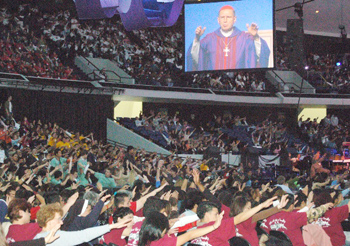 In his opinion, however, the gains in terms of lay participation far outweigh the diminution of latria. (10)
In his opinion, however, the gains in terms of lay participation far outweigh the diminution of latria. (10)
However, without due reverence shown to God, the liturgy becomes self-referential and earth-bound. Reverence and awe are essential responses to the presence of God, a sign that the faithful are conscious of the reality and transcendence of God.
It is obvious to us now that the very idea of reverence and even the instinct for it have by and large disappeared in the modern liturgy. The clergy were the first to disown their duty of reverence towards the Blessed Sacrament, followed by the faithful who seem not to be offended or in the least bothered by its absence.
No smoke without fire
Regarding the hackneyed saying of Pope Paul VI that “through some crack or fissure the smoke of Satan has entered the temple of God,” (11) the question arises: who was the main culprit stoking the fire that sent the smoke swirling about the sanctuary?
No one thought of pointing to Jungmann. He was too erudite, too well respected among the liberal intelligentsia, too well protected by all the Popes from Pius XII to Paul VI. Nonetheless, many of his writings embodied a horror of reverence and a rejection of the supernatural dimensions of the liturgy. By continually promoting the laity to the foreground, he betrayed a desire to obscure the sacredness of the Holy Sacrifice and diminish awareness of the mystery in the minds of the faithful.
The “fissure” was Vatican II’s Liturgy Constitution, particularly its §14, which made the “active participation” of the laity a pivotal point of Catholic worship, thus putting the traditional orientation into reverse. Such a revolution in the lex orandi – reflecting first and foremost the “work of the people” and thereby implying a dishonor to God – could not possibly have been inspired by the Holy Spirit.
Continued


The congregation’s ‘full participaion’ at the Our Father; below, participation takes new dimensions in a Brazilian charismatic Mass
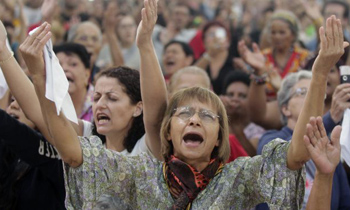
The following extract from his magnum opus illustrates this in a nutshell:
“A thanksgiving prayer rises from the congregation and is borne up to God by the priest; it shifts into the words of consecration, and then into the oblation of the sacred gifts and this oblation, in turn, concludes with a solemn word of praise.” (1)
Here the people’s thanksgiving prayer shades imperceptibly into the words of Consecration so that any distinction between the priest and the laity is extremely blurred. The impression is given that it is the assembled people who are the actual ministers of the Consecration and who together fulfill Christ’s Institution.
“It is the whole believing people who make up the Ecclesia, which approaches God in prayer through the liturgy.” (2) That, Jungmann insisted, was of the essence: “In the early Christian age the liturgy was essentially corporate public worship” (3)
In other words, he was teaching the Protestant notion that the Eucharist is essentially a banquet of the assembled people; it was their action of praise and thanksgiving that gave meaning to the rites. According this progressivist notion, the Church went astray in privileging the priest over the laity in the celebration of the liturgy.
Jungmann’s influence was far-reaching and profound, judging from the man-centered liturgies that are now the norm. There is little, if any, awareness of God in this typical understanding of the Novus Ordo explained by the Carmelite Fr. Gregory Klein:
“Eucharist begins with the assembly, the people gather in the name of Jesus Christ. While the details of the environment in which the people gather, the occasion on which people gather, and the manner in which people gather are not unimportant, Eucharist is about people.” (4)
Less reverence towards God, more ‘active participation’
Jungmann attacked the traditional Mass on the grounds that the congregation had no active role to play, and complained that, correspondingly, “the Mass becomes all the more the mystery of God’s coming to man, a mystery one must adoringly wonder at and contemplate from afar.” (5) [emphasis added]

A liturgy that gives glory to God with pomp and ceremony was distasteful to Jungmann
So, when God and man are weighed in the balance, a marked see-saw effect is produced. Too high an honor paid to God in the liturgy was, according to Jungmann to be avoided, on the grounds that it debased the dignity of the all-important lay people: their “rights” to “actively participate” should always be in the ascendant.
But, since when was it considered unjust and oppressive to put the supreme reverence due to God before the interests of the laity? Only since the Liturgical Movement decided that God was an inconvenient obstacle to their supposed rights to “actively participate” in the liturgy.
With Vatican II, the see-saw has definitely been tilted in favor of man: the Liturgy Constitution mandates that “active participation by all the people is the aim to be considered before all else.” And, lest anyone should fail to appreciate the supreme importance of such participation, the Liturgy Constitution rubs it well in: the phrase is repeated 17 times in the document. (6)
Reverence towards the Blessed Sacrament, an obstacle
As reverence – or lack of it – is ultimately a question of faith, Jungmann revealed the basic objection of the liturgical reformers to putting God first:
“We must see the Tabernacle as a hindrance to the celebration [of Mass] … because the presence of the Blessed Eucharist from the very start of the Mass must prejudice the logic of the course of the celebration.” (7)

Children called to the altar to participate lose the sense of reverence, which leads to a completely casual reception of the Communion, below
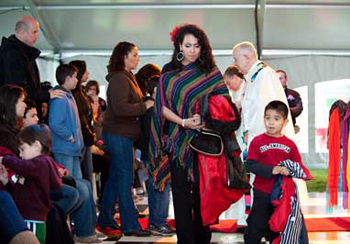
This “people first” logic led to the virtual disappearance of the reverence and solemnity that have traditionally characterized the liturgy, the reception of Communion and devotions in honor of the Blessed Sacrament. And their sudden withdrawal was bound to impact negatively on faith in the Real Presence.
For the symbols and signs of adoration communicated something of the sacred mysteries to the humble faithful in ways that the words by liturgical scholars often failed to convey
Jungmann even went so far as to belittle devotion to the Blessed Sacrament by criticizing the sense of awe displayed by the faithful before the Real Presence:
“The result of this turn to Christ’s Eucharistic presence as God among mortals is an inordinate emphasis on the Eucharist as a sacrificial activity of the priest alone, inducing awe at Christ’s presence among liturgical spectators.” (8)
His theories were behind the drive to marginalize the greatest of all Sacraments: “The measure in which the sacramental Presence becomes central is also the measure in which truly sacramental thinking fades out.” (9)
But, post-conciliar history has proved precisely the opposite to be true: the measure in which the cult of man becomes central is also the measure in which belief in the sacramental Presence fades out.
‘If thou hadst thy way, all reverence should be abolished’ (Job 15:4)
Jungmann admitted to a lessening of esteem for the Real Presence: “The liturgical movement, it has been said, has reduced the honor paid to the Saviour in the Eucharist. That may be so.”

A stadium Mass that looks more like a rock festival... all reverence was abandoned
However, without due reverence shown to God, the liturgy becomes self-referential and earth-bound. Reverence and awe are essential responses to the presence of God, a sign that the faithful are conscious of the reality and transcendence of God.
It is obvious to us now that the very idea of reverence and even the instinct for it have by and large disappeared in the modern liturgy. The clergy were the first to disown their duty of reverence towards the Blessed Sacrament, followed by the faithful who seem not to be offended or in the least bothered by its absence.
No smoke without fire
Regarding the hackneyed saying of Pope Paul VI that “through some crack or fissure the smoke of Satan has entered the temple of God,” (11) the question arises: who was the main culprit stoking the fire that sent the smoke swirling about the sanctuary?
No one thought of pointing to Jungmann. He was too erudite, too well respected among the liberal intelligentsia, too well protected by all the Popes from Pius XII to Paul VI. Nonetheless, many of his writings embodied a horror of reverence and a rejection of the supernatural dimensions of the liturgy. By continually promoting the laity to the foreground, he betrayed a desire to obscure the sacredness of the Holy Sacrifice and diminish awareness of the mystery in the minds of the faithful.
The “fissure” was Vatican II’s Liturgy Constitution, particularly its §14, which made the “active participation” of the laity a pivotal point of Catholic worship, thus putting the traditional orientation into reverse. Such a revolution in the lex orandi – reflecting first and foremost the “work of the people” and thereby implying a dishonor to God – could not possibly have been inspired by the Holy Spirit.
Continued
- Josef Jungmann, The Mass of the Roman Rite, vol. 2, p. 101
- J. Jungmann, ‘The Defeat of Teutonic Arianism and the Revolution of Religious Culture in the Early Middle Ages,’ in Pastoral Liturgy, New York: Herder and Herder, 1962, p. 101. Jungmann had written this essay in 1947.
- Ibid., p. 2.
- Gregory Klein, O. C., Pastoral Foundations of the Sacraments, Paulist Press, 1998, p. 86.
- J. Jungmann, The Mass of the Roman Rite, vol. 1, p. 84
- There are 12 references to “active participation”; four to “participation” as understood in the active sense of the word, and one to “participate intelligently, actively, and easily.”
- J. Jungmann, Announcing The Word of God, translated from the German by Ronald Walls, London : Burns and Oates, 1967, p. 122.
- J. Jungmann, The Place of Christ in Liturgical Prayer, trans. Geoffrey Chapman, Collegeville, MN: The Liturgical Press, 1989, 1965, p. 263. The first edition was published in 1925 when Jungmann was a young university lecturer in Innsbruck. It was praised by two of his devotees, Dom Odo Casel and Fr. Karl Adam, as a major contribution to the Liturgical Movement.
- J. Jungmann, ‘The Defeat of Teutonic Arianism’, p. 88.
- “We understand the Church better, the Church which celebrates the Eucharist, and the unity of the Church which the sacrament calls for; we understand better baptism from which the Church is born; and Scripture, the other table of God which nourishes us at the start of every Eucharistic celebration, has acquired a new and richer relevance.” (J.A. Jungmann, “Eucharistic Piety,” in The Way: A Quarterly Review of Christian Spirituality, London, vol.3, n.2, 1963, p. 94). The journal (1961-1986) was an in-house publication produced by the Jesuits of the Immaculate Conception Church, Farm Street, in the Mayfair district of London.
- “da qualche fessura sia entrato il fumo di Satana nel tempio di Dio”: Homily of Paul VI on 29 June 1972.

Posted February 24, 2016
______________________
______________________
 Volume I |
 Volume II |
 Volume III |
 Volume IV |
 Volume V |
 Volume VI |
 Volume VII |
 Volume VIII |
 Volume IX |
 Volume X |
 Volume XI |
 Special Edition |


